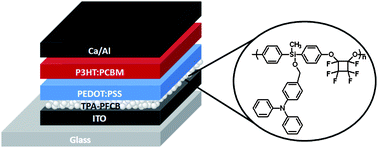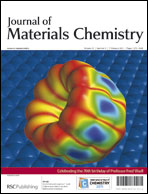Polymer bulk heterojunction solar cells: function and utility of inserting a hole transport and electron blocking layer into the device structure†‡
Abstract
The function and utility of inserting an in situ polymerizable triphenylamine-containing polyperfluorocyclobutane (TPA–PFCB) as a hole transport and electron blocking layer into the structure of bulk heterojunction (BHJ) solar cells were demonstrated. The open-circuit voltage (Voc) and short-circuit current (Jsc) increase, leading to BHJ solar cells with improved power conversion efficiency.

- This article is part of the themed collection: Celebrating the 70th birthday of Professor Fred Wudl

 Please wait while we load your content...
Please wait while we load your content...